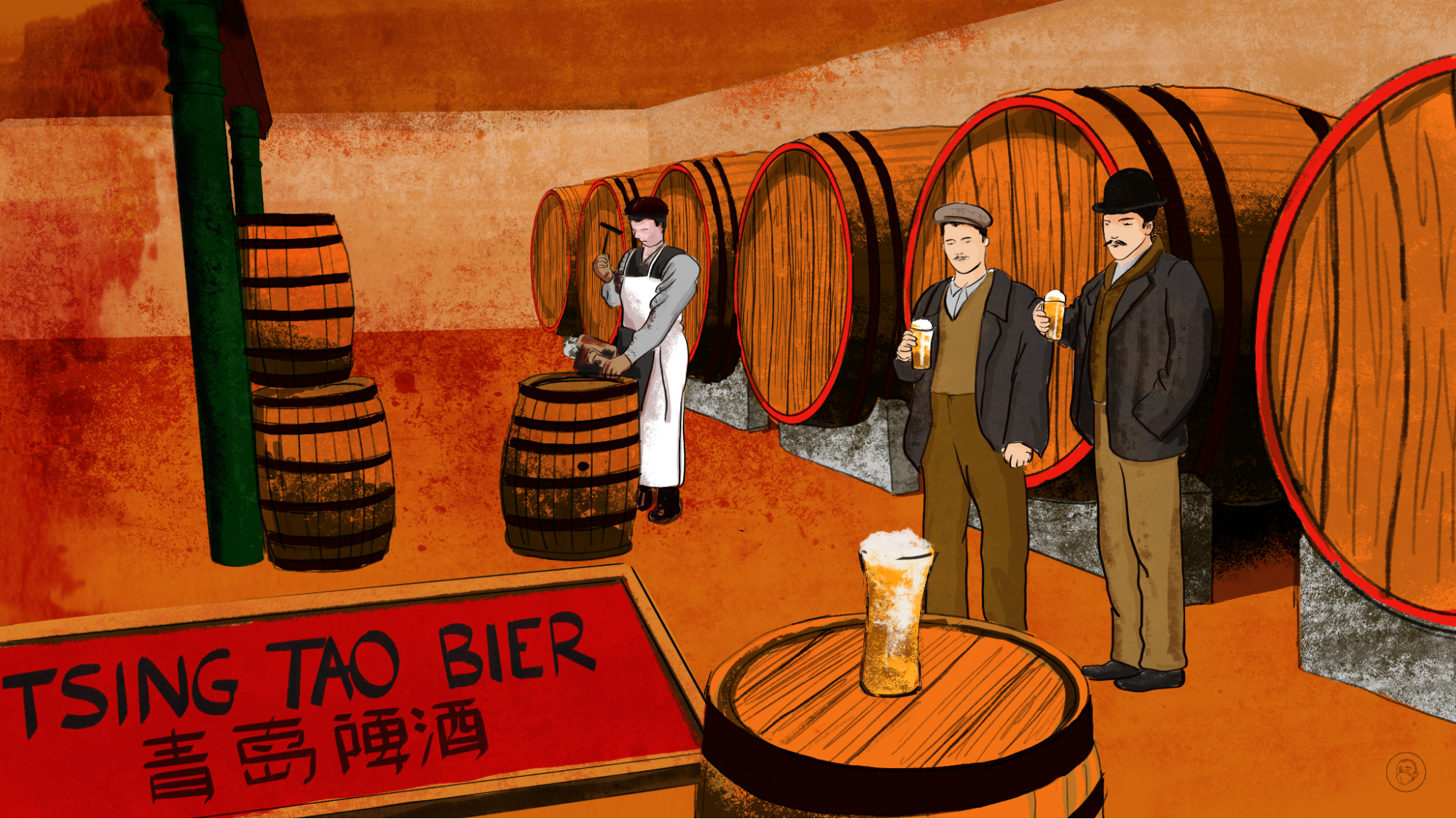The birth of China’s most famous beer
For well over a century, beer has been an important part of the identity of Qingdao, China. But the history of the city’s namesake Tsingtao brewery, with its roots in European colonialism, does not follow a straight line from 1904 till now.

This Week in China’s History: December 22, 1904
It’s the holidays. Whether you’re celebrating Christmas, the end of the year, winter break — or even if you aren’t observing any of those things — there are plenty of chances to raise a glass this time of year. This Week in China’s History looks back 117 years to when the beer that would become China’s most famous, brewed in the Shandong city of Qingdao, was first served.
Qingdao, transliterated Tsingtao in the Post Office system that accompanies Wade-Giles romanization, is the center of European beer tradition in China. It wasn’t the first Chinese city to host a European brewery — that distinction belongs to Harbin, where several groups of Russians, Poles, and Czechs opened breweries right around 1900. The first of these breweries is the ancestor of Harbin Beer (Hā’ěrbīn píjiǔ 哈尔滨啤酒, or Hapi), which is widely available around the world, in large part because it is owned by Anheuser-Busch.
But without question the beer most associated with China is Tsingtao.
For both Qingdao and Harbin, the association of beer with colonialism is clear. The Harbin Brewery was built mainly to supply workers on the Chinese Eastern Railway, Russia’s shortcut to the Pacific across Manchuria. And in Shandong province, the colony at Qingdao was the centerpiece of Germany’s johnny-come-lately imperialism. For all that was going on, it is a little too on-the-nose that one of the first planks of Germany’s imperial project in China was planting hops (brought from Europe) and building a brewery. That the Qingdao region is noted for its springwater, from the nearby mountain Laoshan, made it ideal for beer.
Before we get too carried away, the beer served that December wasn’t technically a “Tsingtao.” And it wasn’t the very first beer made in the city. According to historian Wilhelm Matzat, who was born in the city and maintained the tsingtau.org website until he passed away in 2016, the first brewery in the city was started in 1901, but it lasted just two years. In August of 1903, the Germania Brewery, owned by the Anglo-German Brewery Company, was founded. Its first products passed the lips of consumers on December 22, and went on public sale on New Year’s Eve. One would assume that was an important deadline to hit!
That first beer was similar to what the brewery makes now: a pilsner (pale lager), though other breweries in the city produced hefeweizen and dark lagers. From that time until now, beer has been an important component of the city’s identity. Needless to say, there is not a straight line from 1903 to today.
Not surprisingly, the “Anglo-German” company didn’t survive World War I. Like the city itself, Tsingtao brewery passed from German to Japanese hands during the war. Dai Nippon Brewery — parent of Asahi — took over the brewery in 1916, and retained control of it until the end of World War II. After a brief period of private Chinese ownership, Tsingtao Brewery became a state-owned enterprise after the People’s Republic was founded. Exports abroad began in 1954 — you could get Tsingtao in Britain in the 1950s — and the first Tsingtao was sold in the United States in 1972, after Nixon’s visit.
With that head start, it’s not surprising that Tsingtao remains the No. 1 brand of Chinese beer overseas. More than half of the Chinese beer sold abroad is Tsingtao, although domestically Shenyang’s Snow (itself with colonial roots, having been founded by Japanese during the Manchukuo era) is the top seller.
In terms of sheer volume, China is now the world’s No. 1 consumer of beer, but of course that can be said of many things. In Qingdao, where a new museum and visitors’ center welcomes tourists, beer is a central part of the city’s identity: in the pre-pandemic times, a two-week beer festival in August was top of the tourist calendar, and fresh draft beer, transported in (very flimsy) plastic bags, was available in many small shops. Harbin and a handful of other mass-market breweries have tried to capitalize on the growing trend of beer.
Mild, low in alcohol, crystal-clear lagers — “drinkable” Chinese beers — have their place, but mass-market domestics are not the only tipple available. Paulaner Breweries are now staples of many large cities, making a more flavorful (and more expensive) take on the style, but global brewing trends, which tend to favor bold ales, often high in alcohol and increasingly unfiltered, are also part of the scene. Craft beers are increasingly popular in China. Like the lagers of a century ago, many of them arrived in China to accommodate foreign taste; also like their forebears, they have been adopted and adapted by and to local conditions. There is now a “craft beer revolution” in China.
Unsurprisingly, independent craft beer began in major cities with large foreign populations and presences: Shanghai’s Boxing Cat and Beijing’s Great Leap were among the first, but writer Rick Green lists well over 300 brewpubs, taprooms, and other centers of China’s “craft beer revolution” in his blog The Great Hop Forward. Many of these are founded and/or run by expats, and — although there are some great counterexamples, like Nanjing’s Master Gao Brewery — there is a tendency to see the movement as in some ways mimicking the treaty port and imperialism model that first brought Western-style beer to China.
But it turns out that there is an unexpected indigenous past to craft beer in China.
Historian Charles Kraus has written about a movement, on the eve of the Great Leap Forward, that encouraged local villages to establish their own breweries. A model microbrewery called Yuquan Brewery (玉泉酒厂 yùquán jiǔ chǎng) — “precious spring” — was set up in the outskirts of Harbin (coincidentally the site of China’s first brewery). Supported by the Ministry of Light Industry, author Zhū Méi 朱梅 published a pamphlet, “How to run a small scale brewery,” in 1958 with ambitions to spread brewery culture around the country.
As Kraus describes it, “Zhu’s writing overflowed with excitement for beer. Not just wanting to teach individuals how to brew beer and how to set up a brewery, Zhu also wished for people to actually enjoy drinking the stuff,” celebrate its taste, nutritional value, and (in a challenge to today’s hyperboozey craft brews) low alcohol content.
Zhu’s missionary zeal for beer was grounded in the reality of infrastructure and the economy of the early People’s Republic. Most breweries were in coastal regions — a legacy of the treaty port era — and transporting beer is difficult. Temperature, light, and agitation all degrade beer quickly, making it difficult to get quality product from the coasts (Qingdao, for instance) to inland cities. And even if it made it, Kraus notes that “shipping costs made what was supposed to be a workingman’s drink a precious luxury…‘The price is shockingly expensive,’ Zhu wrote.”
The need for local product and short shipping distances meant that investing in numerous, small breweries was preferable to ramping up production in the big factories. Explaining that breweries needed little land, few resources, and not much labor, Zhu argued that breweries could be in operation quickly across the country, and the manual explained in detail how to make beer, from beginning to end.
Kraus has yet to determine how successful Zhu Mei’s campaign was, but it seems that China’s “craft beer revolution” of the 21st century may have been built on a foundation laid in the 1950s.
In any case, grab a Tsingtao (though if you can get your hands on a Master Gao or Jing A, color me jealous) and enjoy a Chinese beer with this last column of 2021.
This Week in China’s History is a weekly column.





